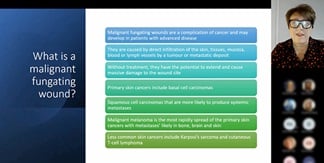When Healing May Not be an Option - How to Effectively Manage Fungating Wounds

- Topics
- Exudate Management, Exuding Wounds, Hard-to-heal Wounds, Maceration, Moderate to Highly Exuding Wounds, Pain
In order to remove necrotic tissue, autolytic debridement is a successful and “tissue friendly” method. It has been demonstrated that HRWD™ have strong hydro-responsive properties, not only to absorb fluid but also to deliver Ringer’s solution to the wound, enabling autolytic debridement. This process softens, loosens, and rinses out necrotic tissue and fibrinous coatings while absorbing bacteria and protein-laden exudate.
HRWD™ dressings can deliver or absorb moisture as required, depending on the environmental fluid balance of the wound, via a balanced isotonic solution containing a mix of sodium, potassium, and calcium salt solutions. The HRWD™ as well as offering excellent exudate management, are also able to manage infection without using any active antimicrobial agent. Instead, bacterial load is reduced via physical means, microbes being absorbed and sequestered within the dressing SAP structure, and can then be removed when the dressing is changed.
This article is a narrative review examining published evidence in relation to HydroClean® (HRWD™), a non-medicated superabsorbent wound dressing, and its antimicrobial effect.
Mark G Rippon
Visiting Clinical Research Associate, University of Huddersfield, UK
Alan A Rogers
Independent Wound Care Consultant, North Wales, UK
Karen J Ousey
Institute for Skin Integrity and Infection Prevention, Department of Nursing and Midwifery, University of Huddersfield, UK